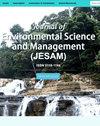Sugarcane Bioethanol Processing Plant in the Philippines: Energetics and Water Inventory
IF 0.3
4区 环境科学与生态学
Q4 ENVIRONMENTAL SCIENCES
引用次数: 1
Abstract
Biofuels production is intended to address shortage on fuel supply. This study assessed the energetics and water inventory of the Philippine bioethanol production from sugarcane, aiming to provide a definitive value from where studies for economic assessment for this system could pick up. A 30-million-liter-per-year (MLPY) processing facility was designed using local field and factory data, from surveys and immersion reports. Assessment showed that sugarcane bioethanol processing facility with co-generation and wastewater treatment units gains a net energy equivalent to 18.62 MJ L-1 of bioethanol produced, with an energy returned on energy invested ratio of 2.75. The net energy realized from the production compensates the energy expended during the construction of the bioethanol plant within about eight months of operation. Water is being used up at a rate of 2,832.22 L per L of ethanol produced or 133.60 L per MJ or 197,826.09 L per Mg of cane processed, accounting the water used for plantation and the factory. The water inventory in the construction level amounts to 952.64 ML. The production of bioethanol from sugarcane is practical, energy-wise, but its water consumption might make the industry unviable in locations where water is scarce.菲律宾甘蔗生物乙醇加工厂:能源和水资源
生物燃料生产旨在解决燃料供应短缺的问题。本研究评估了菲律宾甘蔗生物乙醇生产的能量学和水资源存量,旨在为该系统的经济评估研究提供一个明确的价值。一个3000万升/年(MLPY)的处理设施是利用当地的现场和工厂数据,从调查和浸泡报告中设计的。评估显示,甘蔗生物乙醇加工设施与联合发电和废水处理装置的净能源相当于生产的18.62 MJ L-1生物乙醇,能源投资回报率为2.75。从生产中获得的净能量补偿了在运行约八个月内建造生物乙醇工厂期间消耗的能量。水的消耗率为每生产一升乙醇2832.22升,每兆焦133.60升,每加工一镁甘蔗197826.09升,包括种植园和工厂用水。建筑层面的水资源存量为952.64 ML.从能源角度来看,用甘蔗生产生物乙醇是可行的,但其耗水量可能会使该行业在缺水地区无法生存。
本文章由计算机程序翻译,如有差异,请以英文原文为准。
求助全文
约1分钟内获得全文
求助全文
来源期刊

Journal of Environmental Science and Management
ENVIRONMENTAL SCIENCES-
CiteScore
0.90
自引率
0.00%
发文量
10
审稿时长
2 months
期刊介绍:
The Journal of Environmental Science and Management (JESAM) is an international scientific journal produced semi-annually by the University of the Philippines Los Baños (UPLB).
JESAM gives particular premium to manuscript submissions that employ integrated methods resulting to analyses that provide new insights in environmental science, particularly in the areas of:
environmental planning and management;
protected areas development, planning, and management;
community-based resources management;
environmental chemistry and toxicology;
environmental restoration;
social theory and environment; and
environmental security and management.
 求助内容:
求助内容: 应助结果提醒方式:
应助结果提醒方式:


